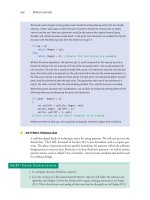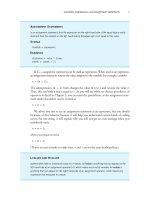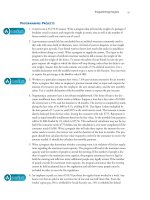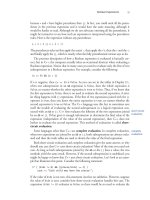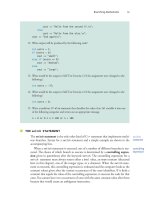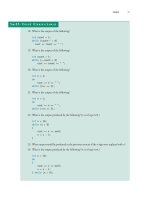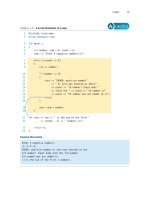Absolute C++ (4th Edition) part 75 potx
Bạn đang xem bản rút gọn của tài liệu. Xem và tải ngay bản đầy đủ của tài liệu tại đây (148.1 KB, 10 trang )
Answers to Self-Test Exercises 747
■ A node is a struct or class object that has one or more member variables that are
pointer variables. These nodes can be connected by their member pointer variables
to produce data structures that can grow and shrink in size while your program is
running.
■ A linked list is a list of nodes in which each node contains a pointer to the next node
in the list.
■ The end of a linked list (or other linked data structure) is indicated by setting the
pointer member variable equal to
NULL.
■ A stack is a first-in/last-out data structure. A queue is a first-in/first-out data struc-
ture. Both can be implemented using a linked list.
■ An iterator is a construct (typically an object of some iterator class) that allows you
to cycle through data items stored in a data structure.
■ A tree is a data structure whose nodes have two (or more) member variables for
pointers to other nodes. If a tree satisfies the Binary Search Tree Storage Rule, then a
function can be designed to rapidly find data in the tree.
ANSWERS TO SELF-TEST EXERCISES
1. Sally
Sally
18
18
Note that (*head).name and head->name mean the same thing. Similarly,
(*head).number and head->number mean the same thing.
2. The best answer is
head->next = NULL;
However, the following is also correct:
(*head).next = NULL;
3. head->item = "Wilbur's brother Orville";
4. class NodeType
{
public:
NodeType( ){}
NodeType(char theData, NodeType* theLink)
: data(theData), link(theLink){}
NodeType* getLink( ) const { return link; }
char getData( ) const { return data; }
void setData(char theData) { data = theData; }
Chapter Summary
17_CH17.fm Page 747 Tuesday, August 19, 2003 10:22 AM
748 Linked Data Structures
void setLink(NodeType* pointer) { link = pointer; }
private:
char data;
NodeType *link;
};
typedef NodeType* PointerType;
5. The value NULL is used to indicate an empty list.
6.
p1 = p1-> next;
7. Pointer discard;
discard = p2->next;//discard points to the node to be deleted.
p2->next = discard->next;
This is sufficient to delete the node from the linked list. However, if you are not using this
node for something else, you should destroy the node with a call to
delete as follows:
delete discard;
8. p1 = p1->getLink( );
9. Pointer discard;
discard = p2->getLink( );//points to node to be deleted.
p2->setLink(discard->getLink( ));
This is sufficient to delete the node from the linked list. However, if you are not using this
node for something else, you should destroy the node with a call to
delete as follows:
delete discard;
10. a. Inserting a new item at a known location into a large linked list is more efficient than
inserting into a large array. If you are inserting into a list, you have about five operations,
most of which are pointer assignments, regardless of the list size. If you insert into an array,
on the average you have to move about half the array entries to insert a data item.
For small lists, the answer is c, about the same.
11. Note that this function is essentially the same as
headInsert in Display 17.11.
template<class T>
void Stack<T>::push(T stackFrame)
{
top = new Node<T>(stackFrame, top);
}
12. //Uses cstddef:
template<class T>
Stack<T>::Stack(const Stack<T>& aStack)
{
if (aStack.isEmpty( ))
17_CH17.fm Page 748 Tuesday, August 19, 2003 10:22 AM
Answers to Self-Test Exercises 749
top = NULL;
else
{
Node<T> *temp = aStack.top;//temp moves
//through the nodes from top to bottom of aStack.
Node<T> *end;//Points to end of the new stack.
end = new Node<T>(temp->getData( ), NULL);
top = end;
//First node created and filled with data.
//New nodes are now added AFTER this first node.
temp = temp->getLink( );//move temp to second node
//or NULL if there is no second node.
while (temp != NULL)
{
end->setLink(
new Node<T>(temp->getData( ), NULL));
temp = temp->getLink( );
end = end->getLink( );
}
//end->link == NULL;
}
}
13. template<class T>
Stack<T>& Stack<T>::operator =(const Stack<T>& rightSide)
{
if (top == rightSide.top) //if two stacks are the same
return *this;
else //send left side back to freestore
{
T next;
while (! isEmpty( ))
next = pop( );//remove calls delete.
}
if (rightSide.isEmpty())
{
top = NULL;
return *this;
}
else
{
Node<T> *temp = rightSide.top;//temp moves through
//the nodes from front top to bottom of rightSide.
Node<T> *end;//Points to end of the left-side stack.
end = new Node<T>(temp->getData( ), NULL);
17_CH17.fm Page 749 Tuesday, August 19, 2003 10:22 AM
750 Linked Data Structures
top = end;;
//First node created and filled with data.
//New nodes are now added AFTER this first node.
temp = temp->getLink();//Move temp to second node
//or set to NULL if there is no second node.
while (temp != NULL)
{
end->setLink(
new Node<T>(temp->getData(), NULL));
temp = temp->getLink();
end = end->getLink();
}
//end->link == NULL;
return *this;
}
}
14. The following should be placed in the namespace QueueSavitch:
//Uses cstddef:
template<class T>
Queue<T>::Queue( ) : front(NULL), back(NULL)
{
//Intentionally empty.
}
//Uses cstddef:
template<class T>
bool Queue<T>::isEmpty( ) const
{
return (back == NULL);//front == NULL would also work
}
15. The following should be placed in the namespace QueueSavitch:
//Uses cstddef:
template<class T>
void Queue<T>::add(T item)
{
if (isEmpty( ))
front = back = new Node<T>(item, NULL);//Sets both
//front and back to point to the only node
else
{
back->setLink(new Node<T>(item, NULL));
back = back->getLink( );
17_CH17.fm Page 750 Tuesday, August 19, 2003 10:22 AM
Answers to Self-Test Exercises 751
}
}
//Uses cstdlib and iostream:
template<class T>
T Queue<T>::remove( )
{
if (isEmpty( ))
{
cout << "Error: Removing an item from an empty queue.\n";
exit(1);
}
T result = front->getData( );
Node<T> *discard;
discard = front;
front = front->getLink( );
if (front == NULL) //if you removed the last node
back = NULL;
delete discard;
return result;
}
16. The following should be placed in the namespace QueueSavitch:
template<class T>
Queue<T>::~Queue( )
{
T next;
while (! isEmpty( ))
next = remove( );//remove calls delete.
}
17. The following should be placed in the namespace QueueSavitch:
//Uses cstddef:
template<class T>
Queue<T>::Queue(const Queue<T>& aQueue)
{
if (aQueue.isEmpty( ))
front = back = NULL;
else
{
Node<T> *temp = aQueue.front;//temp moves
//through the nodes from front to back of aQueue.
back = new Node<T>(temp->getData( ), NULL);
17_CH17.fm Page 751 Tuesday, August 19, 2003 10:22 AM
752 Linked Data Structures
front = back;
//First node created and filled with data.
//New nodes are now added AFTER this first node.
temp = temp->getLink( );//temp now points to second
//node or NULL if there is no second node.
while (temp != NULL)
{
back->setLink(new Node<T>(temp->getData( ), NULL));
back = back->getLink( );
temp = temp->getLink( );
}
//back->link == NULL
}
}
18. The following should be placed in the namespace QueueSavitch:
//Uses cstddef:
template<class T>
Queue<T>& Queue<T>::operator =(const Queue<T>& rightSide)
{
if (front == rightSide.front)//if the queues are the same
return *this;
else //send left side back to freestore
{
T next;
while (! isEmpty( ))
next = remove( );//remove calls delete.
}
if (rightSide.isEmpty( ))
{
front = back = NULL;
return *this;
}
else
{
Node<T> *temp = rightSide.front;//temp moves
//through the nodes from front to back of rightSide.
back = new Node<T>(temp->getData( ), NULL);
front = back;
//First node created and filled with data.
//New nodes are now added AFTER this first node.
temp = temp->getLink( );//temp now points to second
17_CH17.fm Page 752 Tuesday, August 19, 2003 10:22 AM
Answers to Self-Test Exercises 753
//node or NULL if there is no second node.
while (temp != NULL)
{
back->setLink(
new Node<T>(temp->getData( ), NULL));
back = back->getLink( );
temp = temp->getLink( );
}
//back->link == NULL;
return *this;
}
}
19. using namespace ListNodeSavitch;
using namespace QueueSavitch;
template<class T>
bool inQ(Queue<T> q, T target)
{
Queue<T>::Iterator i;
i = q.begin( );
while ((i != q.end( )) && (*i != target))
i++;
return (i != q.end());
}
Note that the following return statement does not work, since it can cause a dereferencing
of
NULL, which is illegal. The error would be a runtime error, not a compiler error.
return (*i == target);
20. The template class SearchTree needs function declarations added. These are just the
definitions.
template<class T> //uses iostream:
void SearchTree<T>::preorderShow( ) const
{
preorderShow(root);
}
template<class T> //uses iostream:
void SearchTree<T>::preorderShow(
TreeNode<T>* subTreeRoot) const
{
if (subTreeRoot != NULL)
{
cout << subTreeRoot->data << " ";
preorderShow(subTreeRoot->leftLink);
17_CH17.fm Page 753 Tuesday, August 19, 2003 10:22 AM
754 Linked Data Structures
preorderShow(subTreeRoot->rightLink);
}
}
template<class T> //uses iostream:
void SearchTree<T>::postorderShow( ) const
{
postorderShow(root);
}
template<class T> //uses iostream:
void SearchTree<T>::postorderShow(
TreeNode<T>* subTreeRoot) const
{
if (subTreeRoot != NULL)
{
postorderShow(subTreeRoot->leftLink);
postorderShow(subTreeRoot->rightLink);
cout << subTreeRoot->data << " ";
}
}
PROGRAMMING PROJECTS
1. Write a void function that takes a linked list of integers and reverses the order of its nodes.
The function will have one call-by-reference parameter that is a pointer to the head of the
list. After the function is called, this pointer will point to the head of a linked list that has
the same nodes as the original list but in the reverse of the order they had in the original
list. Note that your function will neither create nor destroy any nodes. It will simply rear-
range nodes. Place your function in a suitable test program.
2. Write a function called
mergeLists that takes two call-by-reference arguments that are
pointer variables that point to the heads of linked lists of values of type
int. The two
linked lists are assumed to be sorted so that the number at the head is the smallest number,
the number in the next node is the next smallest, and so forth. The function returns a
pointer to the head of a new linked list that contains all the nodes in the original two lists.
The nodes in this longer list are also sorted from smallest to largest values. Note that your
function will neither create nor destroy any nodes. When the function call ends, the two
pointer variable arguments should have the value
NULL.
3. Design and implement a class that is a class for polynomials. The polynomial
a
n
x
n
+
a
n
-1
x
n
-1
+
+
a
0
will be implemented as a linked list. Each node will contain an int value for the power of x
and an
int value for the corresponding coefficient. The class operations should include
addition, subtraction, multiplication, and evaluation of a polynomial. Overload the
17_CH17.fm Page 754 Tuesday, August 19, 2003 10:22 AM
Programming Projects 755
operators +, −, and * for addition, subtraction, and multiplication. Evaluation of a polyno-
mial is implemented as a member function with one argument of type
int. The evaluation
member function returns the value obtained by plugging in its argument for x and per-
forming the indicated operations.
Include four constructors: a default constructor, a copy constructor, a constructor with a
single argument of type
int that produces the polynomial that has only one constant term
that is equal to the constructor argument, and a constructor with two arguments of type
int that produces the one-term polynomial whose coefficient and exponent are given by the
two arguments. (In the previous notation the polynomial produced by the one-argument
constructor is of the simple form consisting of only a
0
. The polynomial produced by the
two-argument constructor is of the slightly more complicated form a
n
x
n
.) Include a suit-
able destructor. Include member functions to input and output polynomials.
When the user inputs a polynomial, the user types in the following:
a
n
x^
n
+
a
n
-1
x^
n
-1 + +
a
0
However, if a coefficient a
i
is 0, the user may omit the term a
i
x^ i. For example, the
polynomial
3
x
4
+ 7
x
2
+ 5
can be input as
3x^4 + 7x^2 + 5
It could also be input as
3x^4 + 0x^3 + 7x^2 + 0x^1 + 5
If a coefficient is negative, a minus sign is used in place of a plus sign, as in the following
examples:
3x^5 − 7x^3 + 2x^1 − 8
−7x^4 + 5x^2 + 9
A minus sign at the front of the polynomial, as in the second of the above two examples,
applies only to the first coefficient; it does not negate the entire polynomial. Polynomials
are output in the same format. In the case of output, the terms with 0 coefficients are not
output. To simplify input, you can assume that polynomials are always entered one per line
and that there will always be a constant term a
0
. If there is no constant term, the user
enters 0 for the constant term, as in the following:
12x^8 + 3x^2 + 0
4. Part A. The annotation in Display 17.24 says that a real SearchTree template class should
have a copy constructor, an overloaded assignment operator, other overloaded operators,
and other member functions. Obtain the code for Display 17.24 and add declarations for
17_CH17.fm Page 755 Tuesday, August 19, 2003 10:22 AM
756 Linked Data Structures
the following functions and overloaded operators: the default constructor, copy construc-
tor,
delete, overloaded operator, =, makeEmpty, height, size, preOrderTraversal,
inOrderTraversal, and postOrderTraversal. The functions preOrderTraversal,
inOrderTraversal, and postOrderTraversal each call a global function process to
process the nodes as they are encountered. The function
process is a friend of the
SearchTree class and for this exercise it is only a stub.
Supply preconditions and postconditions for these functions describing what each function
should do.
The function
height has no parameters and returns the height of the tree. The height of
the tree is the maximum of the heights of all the nodes. The height of a node is the number
of links between it and the root node.
The function
size has no parameters and returns the number of nodes in the tree.
The function
makeEmpty removes all the nodes from the tree and returns the memory used
by the nodes for reuse. The
makeEmpty function leaves the root pointer with the value
NULL.
Part B. Implement the member and friend functions and overloaded operators. Note that
some of the functions listed here are already implemented in the text. You should make full
use of the text’s code. You should test your package thoroughly.
Part C: Design and implement an iterator class for the tree class. You will need to decide
what a
begin, and end, element means for your searchTree, and what will be the next
element the
++ operator will point to.
Hint 1: You might maintain a private size variable that is increased by insertion and
decreased by deletion, and whose value is returned by the
size function. An alternative
(use this if you know calls to size will be quite infrequent) is to calculate the size when you
need it by traversing the tree. Similar techniques, though with more sophisticated details,
can be used to implement the
height function.
Hint 2: Do these a few members at a time. Compile and test after doing each group of a
few members. You will be glad you did it this way.
Hint 3: Before you write the operator,
=, and copy constructor, note that their jobs have a
common task—duplicating another tree. Write a
copyTree function that abstracts out the
common task of the copy constructor and operator,
=. Then write these two important
functions using the common code.
Hint 4: The function
makeEmpty and the destructor have a common tree destruction task.
17_CH17.fm Page 756 Tuesday, August 19, 2003 10:22 AM
